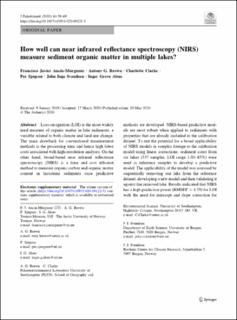How well can near infrared reflectance spectroscopy (NIRS) measure sediment organic matter in multiple lakes?
Ancin Murguzur, Francisco Javier; Brown, Antony; Clarke, Charlotte; Sjøgren, Per Johan E; Svendsen, John-Inge; Alsos, Inger Greve
Journal article, Peer reviewed
Published version

Åpne
Permanent lenke
https://hdl.handle.net/11250/2755781Utgivelsesdato
2020Metadata
Vis full innførselSamlinger
- Department of Earth Science [1103]
- Registrations from Cristin [10412]
Sammendrag
Loss-on-ignition (LOI) is the most widely used measure of organic matter in lake sediments, a variable related to both climate and land-use change. The main drawback for conventional measurement methods is the processing time and hence high labor costs associated with high-resolution analyses. On the other hand, broad-based near infrared reflectance spectroscopy (NIRS) is a time and cost efficient method to measure organic carbon and organic matter content in lacustrine sediments once predictive methods are developed. NIRS-based predictive models are most robust when applied to sediments with properties that are already included in the calibration dataset. To test the potential for a broad applicability of NIRS models in samples foreign to the calibration model using linear corrections, sediment cores from six lakes (537 samples, LOI range 1.03–85%) were used as reference samples to develop a predictive model. The applicability of the model was assessed by sequentially removing one lake from the reference dataset, developing a new model and then validating it against the removed lake. Results indicated that NIRS has a high predictive power (RMSEP < 4.79) for LOI with the need for intercept and slope correction for new cores measured by NIRS. For studies involving many samples, NIRS is a cost and time-efficient method to estimate LOI on a range of lake sediments with only linear bias adjustments for different records.
